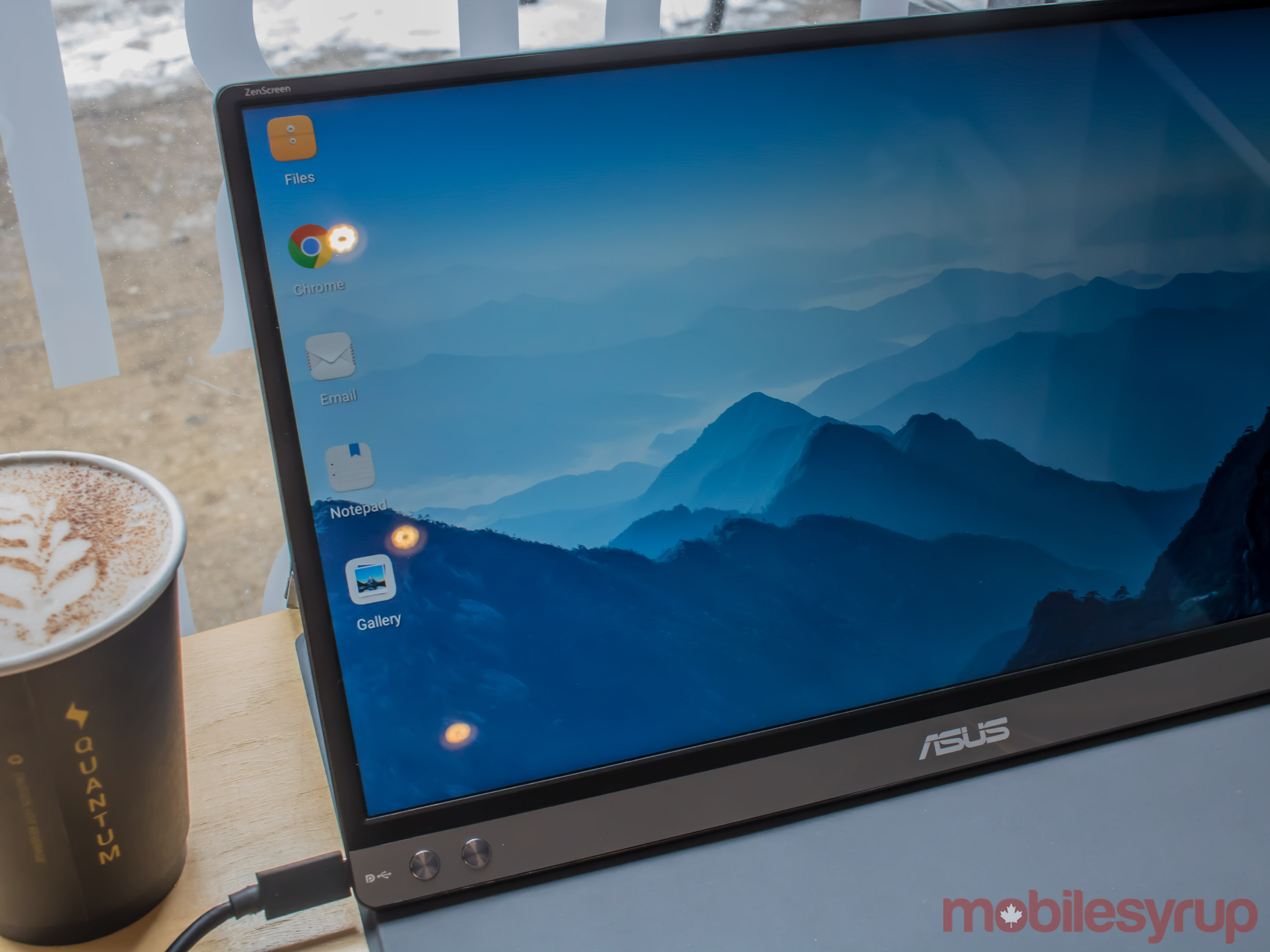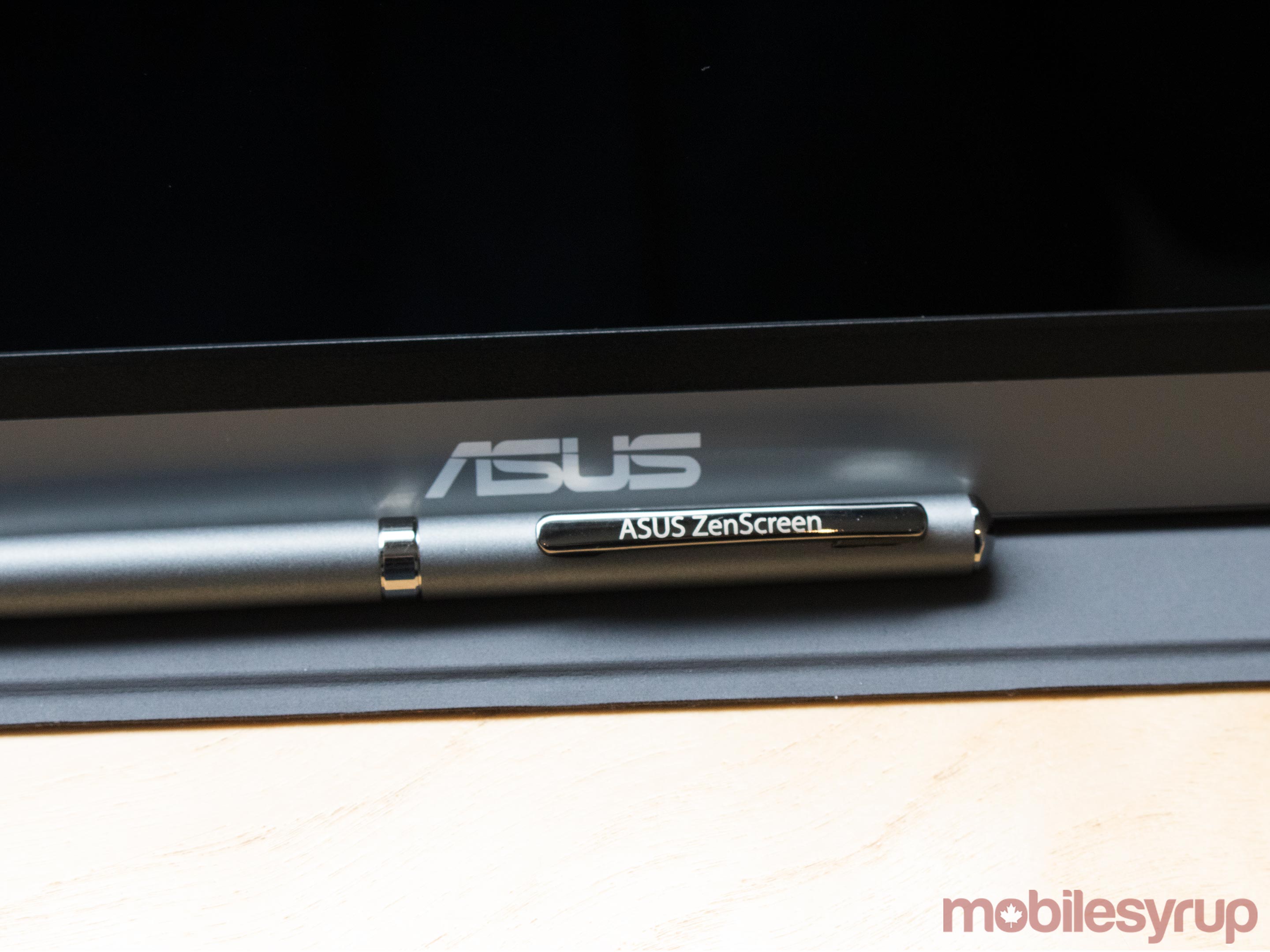
In keeping with our mobile mandate, MobileSyrup usually doesn’t review monitors. The Asus ZenScreen caught our eyes, however, precisely because it is mobile and easily portable.
In fact, out of the box the ZenScreen only comes with a case, a pen, a USB Type-C cable, and a USB Type-C to USB Type-A adapter. The inclusion of solely those four items gives rise to questions like: How does the display stand? How does it get power? And why does a monitor come with a pen?
After using the ZenScreen on a daily basis, however, it became clear the device comes with everything it needs and more.
Portability

Asus launched the ZenScreen last year as a portable device with a depth of only 8mm and weight of only 0.78kg (1.71 lbs) — a little heavier than the Surface 2, but lighter than the Surface 2 Pro.
The monitor connects to a laptop or smartphone via USB Type-C, meaning the ZenScreen doesn’t require a separate power cord. Instead, the ZenScreen consumes all the power it needs from the connected laptop, though not enough to greatly effect the laptop’s reserves.
The monitor’s case also helps with the device’s portability, as there’s no need to worry about scuffing the display when placed in a bag. Additionally the ZenScreen’s case works as a magnetic stand for the monitor and allows the ZenScreen to stand a variety of positions. And it doesn’t add very much weight to the ZenScreen, so it’s still manageable.
Display and design

The ZenScreen features a wide screen 15.6-inch IPS display with a 1920 x 1080 pixel resolution, 200 nits of brightness, 60Hz refresh rate, 5ms response time and support for the sRGB colour gamut. Using the display with the Asus Flipbook S was perfect as they both share the same pixel resolution. The Flipbook S’ has a greater pixel density than the ZenScreen, but it didn’t make much of a difference.
While using the monitor with the 3840 x 2160 pixel Lenovo Yoga 920, however, there was a noticeable dip in quality when I shifted from one screen to the other.
With this in mind, note that the ZenScreen pairs much better with other 1080p displays.
The ZenScreen also features eight screen settings to help with different lighting situations, such as ‘RGB mode,’ ‘scenery mode,’ ‘theater mode,’ ‘standard mode,’ ‘reading mode,’ ‘darkroom mode’ and ‘night view mode.’ These modes all slightly change the display enough to help with watching videos, viewing pictures, reading in the dark and working. I kept the screen on ‘standard,’ as that was my preferred viewing option.
The device also has a blue light filter, for those who do not like the strong blue tint.
Below the display is a bezel that hosts a pair of buttons on the bottom left corner for changing settings. To right of these buttons is the Asus logo and further to the right is a power button and a circular hole.
Amazing pen

What I liked most about the ZenScreen was the fact that its accompanying ink pen doubles as a stand for the ZenScreen.
Users can place the pen in the hole, to the right of the logo, and it will hold up the monitor up about 75 degrees, which is helpful when working or watching Netflix videos. The pen setup is surprisingly sturdy and as long as it’s on a hard surface, it holds it up well. It also makes the display even more easy to carry around, since users can travel with just the screen and the pen. In fact, most pens will work for this purpose, not just the one provided by Asus.
For those who don’t like the pen stand’s upright angle, the magnetic case doubles as a stand and can hold the monitor up at a variety of angles.
The ZenScreen is able to rotate automatically, meaning the device can be used in portrait mode. To do this, however, both the Asus DisplayWidget and Windows 10 are necessary. After they’re installed, users can read full documents or books pages in portrait mode.
The pen also functions as a pen.
Great experience for specific use

With the pen functionality, the one USB Type-C port — with a USB Type-A adapter — and the magnetic case that doubles as a stand, the ZenScreen makes for an interesting monitor.
The problem with a monitor like this is that it’s not ergonomically set up. Looking down at the monitor in landscape mode isn’t great for your back or neck. Having the display go into a vertical mode, or finding a way to hold it up helps this issue, though.
I also wish it was a touchscreen, but unfortunately, that’s not the case. Other than those issues, I really enjoyed using this monitor.
I carried it back and forth between work and home nearly every day and didn’t notice it very much within my bag because of how light it was. Discovering the cool things that can be done with the pen brought me joy and using it for work everyday made my job easier — though any monitor could do the latter.
The ZenScreen retails for $349.99, though it’s possible to pick up a normal monitor for half the price, at least 20 inches or larger and with better pixel resolution. Even with better portability, it’s questionable whether a 15-inch monitor is worth $350.
That said, for very specific use cases, the ZenScreen could be great.


